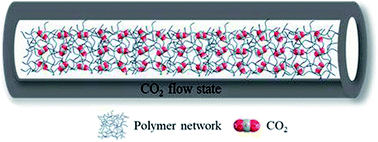Achieving solubility alteration with functionalized polydimethylsiloxane for improving the viscosity of supercritical CO2 fracturing fluids†
Abstract
Supercritical carbon dioxide (SC-CO2) fracturing technology has the characteristics of a large amount of fixed CO2 and anhydrous fracturing. It has great application potential for developing unconventional oil and gas resources and mitigating the greenhouse effect. However, the low viscosity of SC-CO2 limits the development of this technology. In this work, HS series thickeners were prepared via a ring-opening polymerization and hydrosilylation reaction by a molecular simulation-aided design method. The simulation results of cohesive energy density, interaction energy, and radial distribution function are consistent with the visualization experimental results, which proves that HS (hyperbranched siloxane) series thickeners have excellent solubility in SC-CO2. HS-3 is the best thickener in the HS series. At 305.15 K and 10 MPa, 5 wt% HS-3 (60 s−1) increases the viscosity of SC-CO2 by 151 times, and the apparent viscosity is 3.024 mPa s. The apparent viscosity of SC-CO2 was positively correlated with the pressure and concentration but negatively correlated with the temperature and shear rate. The results indicate that it is feasible to introduce an aliphatic group and polysiloxane into a SC-CO2 thickener by hydrosilylation.



 Please wait while we load your content...
Please wait while we load your content...